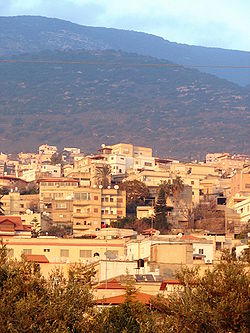Rameh
| |
|---|---|
Local council (from 2005) | |
| Hebrew transcription(s) | |
| • ISO 259 | Ráma |
| • Also spelled | Rame (official) al-Rama (unofficial) |
 | |
| Coordinates: 32°56′21″N 35°22′02″E / 32.93917°N 35.36722°E | |
| Grid position | 184/260 PAL |
| Country | |
| District | Northern |
| Area | |
| • Total | 6,118 dunams (6.118 km2 or 2.362 sq mi) |
| Population (2022)[1] | |
| • Total | 7,798 |
| • Density | 1,300/km2 (3,300/sq mi) |
| Ethnicity | |
| • Arabs | 99.8% |
| • Jews and others | 0.2% |
| Name meaning | "Lofty" or "Elevated"[2] |
Rameh (Arabic: الرامة; Hebrew: רָמָה; alternatively spelled ar-Rame or ar-Rama) is an Arab town in the Northern District of Israel. Located east of Nahf and Karmiel, in 2022 it had a population of 7,798.[1] Over half of the inhabitants are Christians, mostly Greek Orthodox and Greek Catholic, over a third are Druze and the remainder are Muslims.
A village council was established for Rameh under the British in 1922, of the first in Mandatory Palestine. Rameh's Christian and Muslim residents were temporarily expelled after its capture by Israeli forces in the 1948 Arab-Israeli War, but they returned to the village, which also became home to many internally displaced Palestinians from nearby villages. A village council was established in 1954 by the Israeli government to oversee village affairs; from 1959 on, council members were elected. As of the 1960s, the people of Rameh have been noted for their high levels of education and standards of living. The village was home to the well-known poet Samih al-Qasim, the Greek Orthodox archbishop Atallah Hanna and artist Mira Awad.
The village is well known for its diverse cuisine, which draws many visitors from across the country. It is also noteworthy for being surrounded by vast olive groves and for producing high-quality olive oil.[3][4]
- ^ a b c "Regional Statistics". Israel Central Bureau of Statistics. Retrieved 21 March 2024.
- ^ Palmer, 1881, p. 92
- ^ "האם שמן הזית הטוב בעולם נמצא בכפר ראמה? לפי תושביו התשובה היא כן". הארץ (in Hebrew). Retrieved 2023-03-24.
- ^ "אוכל גלילי אותנטי, ערק ייחודי ומטבח בולגרי. כל הסיבות לבקר בראמה". הארץ (in Hebrew). Retrieved 2023-03-24.

